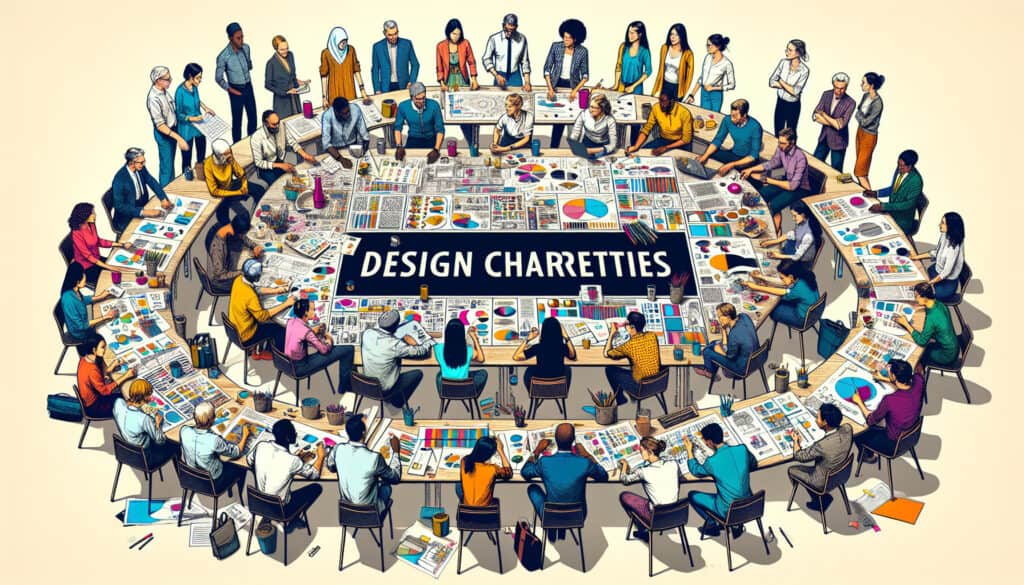An intense, collaborative design workshop where stakeholders (designers, clients, users, experts) come together to brainstorm and develop a solution to a problema de diseño in a concentrated period.
- Metodologías: Clientes y marketing, Economía
Design Charrettes

Design Charrettes
- Metodología ágil, Lluvia de ideas, Colaboración multifuncional, Pensamiento de diseño, Diseño centrado en el ser humano, Desarrollo iterativo, Creación de prototipos, Diseño centrado en el usuario
Objetivo:
Cómo se utiliza:
- A charrette is a fast-paced, hands-on session where multiple ideas are proposed and sketched. The goal is to quickly generate and converge on a design direction through rapid collaboration.
Ventajas
- Fosters collaboration and gets all stakeholders on the same page; generates a large number of ideas and a viable design solution very quickly; builds consensus and shared ownership.
Contras
- Can be exhausting and stressful due to the high intensity; requires a skilled facilitator to keep the session on track; the quality of the outcome depends on the quality of the participants.
Categorías:
- Ideación, Diseño de producto, Gestión de proyectos
Ideal para:
- Rapidly co-creating a solution to a design problem in a short, intensive, and collaborative workshop.
Design charrettes are frequently utilized in urban planning, architecture, and product development, bringing together diverse stakeholders such as designers, engineers, clients, and users throughout the different phases of a project, particularly during ideation and concept refinement. These intensive workshops often occur early in the design process, allowing rapid ideation and synthesis of varied perspectives that can enrich the final product. For example, in the context of urban redevelopment, a charrette may include local residents, planners, and environmental experts to collaboratively envision community spaces that meet ecological, social, and economic needs. This methodology provides a structured yet flexible format for brainstorming solutions, often utilizing sketching and visual tools to communicate ideas swiftly, which can lead to breakthrough innovations that might not arise in standard meetings. The participatory nature encourages engagement and can significantly reduce the time spent on revisions and misunderstandings later in the project by aligning different viewpoints early on. Organizations like the American Institute of Architects promote this approach for its ability to cultivate community involvement and garner a sense of shared investment in the outcomes, creating a platform where everyone can contribute, thus leading to a more centrado en el usuario design solution. Each session typically culminates in a tangible output or preliminary design direction that serves as a reference point for subsequent phases of development, reinforcing the commitment to collaboration and shared ownership among all participants, which is crucial for successful outcomes in interdisciplinary projects.
Pasos clave de esta metodología
- Define the design problem clearly and ensure all participants understand it.
- Encourage idea generation through brainstorming and sketching sessions.
- Organize participants into small groups for focused discussions and ideation.
- Facilitate quick presentations of ideas from each group to share insights.
- Collect feedback on presented ideas from the entire group.
- Identify patterns and common themes among the ideas generated.
- Collaboratively refine and prioritize ideas for further development.
- Converge on a selected design direction that reflects collective input.
Consejos profesionales
- Incorporate rapid prototyping tools during the session to visualize concepts in real-time, enhancing understanding and engagement.
- Assign specific roles to participants, such as facilitator, scribe, and sketch artist, to optimize contributions and keep the session organized.
- Utilize divergent and convergent thinking techniques alternately, encouraging wild ideas before narrowing down to actionable solutions.
Leer y comparar varias metodologías, recomendamos el
> Amplio repositorio de metodologías <
junto con otras más de 400 metodologías.
Sus comentarios sobre esta metodología o información adicional son bienvenidos en la dirección sección de comentarios ↓ , así como cualquier idea o enlace relacionado con la ingeniería.
Contexto histórico
1949
1950
1950
1960
1960
1960
1960
1940
1950
1950
1958
1960
1960
1960
1960
(si se desconoce la fecha o no es relevante, por ejemplo "mecánica de fluidos", se ofrece una estimación redondeada de su notable aparición)















Publicaciones relacionadas
Gestión de operaciones de fabricación (MOM)
Sistema de Ejecución de Fabricación (MES)
Plan de control de la fabricación
Pruebas manuales
Tablas de evaluación de la manipulación manual (MAC)
ManTRA (Herramienta de evaluación de riesgos en las tareas manuales)